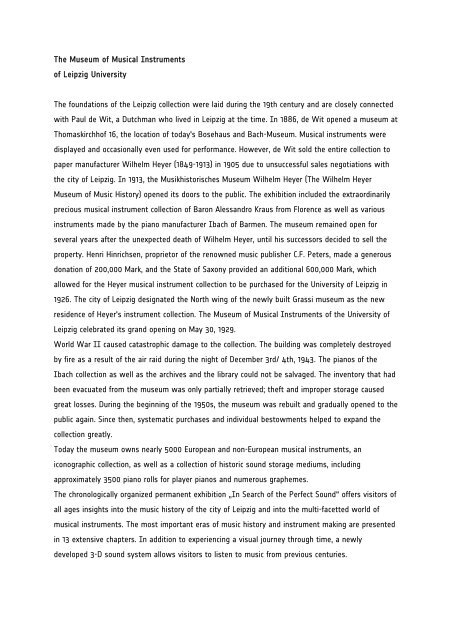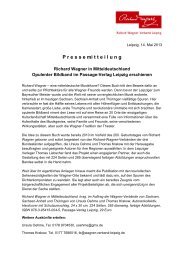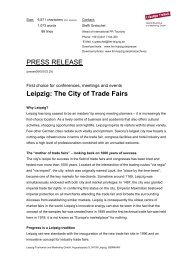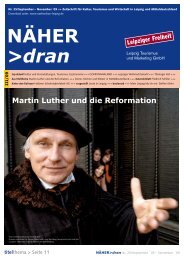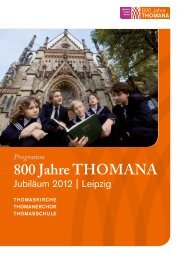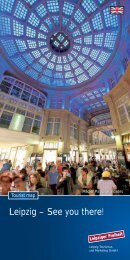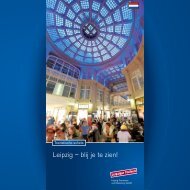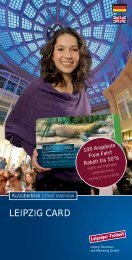The Museum of Musical Instruments
The Museum of Musical Instruments
The Museum of Musical Instruments
You also want an ePaper? Increase the reach of your titles
YUMPU automatically turns print PDFs into web optimized ePapers that Google loves.
<strong>The</strong> <strong>Museum</strong> <strong>of</strong> <strong>Musical</strong> <strong>Instruments</strong><br />
<strong>of</strong> Leipzig University<br />
<strong>The</strong> foundations <strong>of</strong> the Leipzig collection were laid during the 19th century and are closely connected<br />
with Paul de Wit, a Dutchman who lived in Leipzig at the time. In 1886, de Wit opened a museum at<br />
Thomaskirchh<strong>of</strong> 16, the location <strong>of</strong> today's Bosehaus and Bach-<strong>Museum</strong>. <strong>Musical</strong> instruments were<br />
displayed and occasionally even used for performance. However, de Wit sold the entire collection to<br />
paper manufacturer Wilhelm Heyer (1849-1913) in 1905 due to unsuccessful sales negotiations with<br />
the city <strong>of</strong> Leipzig. In 1913, the Musikhistorisches <strong>Museum</strong> Wilhelm Heyer (<strong>The</strong> Wilhelm Heyer<br />
<strong>Museum</strong> <strong>of</strong> Music History) opened its doors to the public. <strong>The</strong> exhibition included the extraordinarily<br />
precious musical instrument collection <strong>of</strong> Baron Alessandro Kraus from Florence as well as various<br />
instruments made by the piano manufacturer Ibach <strong>of</strong> Barmen. <strong>The</strong> museum remained open for<br />
several years after the unexpected death <strong>of</strong> Wilhelm Heyer, until his successors decided to sell the<br />
property. Henri Hinrichsen, proprietor <strong>of</strong> the renowned music publisher C.F. Peters, made a generous<br />
donation <strong>of</strong> 200,000 Mark, and the State <strong>of</strong> Saxony provided an additional 600,000 Mark, which<br />
allowed for the Heyer musical instrument collection to be purchased for the University <strong>of</strong> Leipzig in<br />
1926. <strong>The</strong> city <strong>of</strong> Leipzig designated the North wing <strong>of</strong> the newly built Grassi museum as the new<br />
residence <strong>of</strong> Heyer's instrument collection. <strong>The</strong> <strong>Museum</strong> <strong>of</strong> <strong>Musical</strong> <strong>Instruments</strong> <strong>of</strong> the University <strong>of</strong><br />
Leipzig celebrated its grand opening on May 30, 1929.<br />
World War II caused catastrophic damage to the collection. <strong>The</strong> building was completely destroyed<br />
by fire as a result <strong>of</strong> the air raid during the night <strong>of</strong> December 3rd/ 4th, 1943. <strong>The</strong> pianos <strong>of</strong> the<br />
Ibach collection as well as the archives and the library could not be salvaged. <strong>The</strong> inventory that had<br />
been evacuated from the museum was only partially retrieved; theft and improper storage caused<br />
great losses. During the beginning <strong>of</strong> the 1950s, the museum was rebuilt and gradually opened to the<br />
public again. Since then, systematic purchases and individual bestowments helped to expand the<br />
collection greatly.<br />
Today the museum owns nearly 5000 European and non-European musical instruments, an<br />
iconographic collection, as well as a collection <strong>of</strong> historic sound storage mediums, including<br />
approximately 3500 piano rolls for player pianos and numerous graphemes.<br />
<strong>The</strong> chronologically organized permanent exhibition „In Search <strong>of</strong> the Perfect Sound“ <strong>of</strong>fers visitors <strong>of</strong><br />
all ages insights into the music history <strong>of</strong> the city <strong>of</strong> Leipzig and into the multi-facetted world <strong>of</strong><br />
musical instruments. <strong>The</strong> most important eras <strong>of</strong> music history and instrument making are presented<br />
in 13 extensive chapters. In addition to experiencing a visual journey through time, a newly<br />
developed 3-D sound system allows visitors to listen to music from previous centuries.
<strong>The</strong> exhibition contains the following sections:<br />
• Renaissance: Frembde canzones und gute teutsche Liedlein ("Foreign Canzonas and Good German<br />
Songs")<br />
• Heinrich Schütz: Longing for Harmonic Order<br />
• Bartolomeo Crist<strong>of</strong>ori: Instrument Making at the Medici Court<br />
• Johann Sebastian Bach: Director chori musici<br />
• Zimeliensaal (Treasure Room) – Display <strong>of</strong> Especially Precious <strong>Musical</strong> <strong>Instruments</strong><br />
• <strong>Musical</strong> Art around 1800 – Master Performers and Enthusiasts<br />
• Stein & Streicher – Four Generations <strong>of</strong> Effort and Assiduity<br />
• Romantic Period – "…Feelings Lost in Love…"<br />
• Saxony, a Major Music Supplier<br />
• "<strong>The</strong> voice sounds and fades away…" – Automated <strong>Instruments</strong><br />
• Changing Times<br />
• New Renaissance – A New Interest in Old Music.<br />
<strong>The</strong> Klanglabor (sound laboratory) <strong>of</strong>fers visitors a hands-on experience by allowing them to try out<br />
various musical instruments.<br />
Opening Hours<br />
Tuesday-Sunday and on movable feasts: 10 a.m. - 6 p.m., Closed on December 24 and December 31<br />
Admission<br />
€5,00 (€3,00 concessions)<br />
Reduction is <strong>of</strong>fered for students, unemployed, disabled persons, apprentices.<br />
Combined ticket (for the 3 museums inside the GRASSI) - Main exhibition: €12,00 (€9,00 concessions)<br />
Audio guide €1,00<br />
Guided tours<br />
lump sum €50,00 (25 persons max., 8 persons min.) plus reduced price for each participant<br />
Guided tours are <strong>of</strong>fered in English as well as various other languages. For further information, please<br />
call +49 (0) 341/9730750.<br />
Museen im Grassi | <strong>Museum</strong> für Musikinstrumente der Universität Leipzig<br />
04103 Leipzig | Johannisplatz 5-11 | www.grassimuseum.de<br />
musik.museum@uni-leipzig.de


